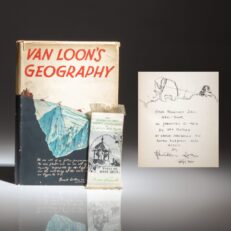Description
The first edition of Sledge: The British Trans-Greenland Expedition 1934 by Martin Lindsay, inscribed by polar explorer Vilhjalmur Stefansson to a fellow arctic explorer, Major General Julius K. Lacey.
Octavo, xi, [1], 342pp, [3]. Publisher’s blue cloth, title stamped on spine. Stated “First published 1935” on copyright page. Boards rubbed and soiled, cloth spine sunned. Wear to rear paste down. Complete with 48 photographic plates, a frontispiece and a folding panorama by Andrew Croft. Light foxing throughout, occasional foxing to plates. Solid text block. Also complete with five maps, one a fold-out in fine condition. In the publisher’s scarce dust jacket, with “21s. net” on front flap, light soiling to spine, wear and shallow chipping along top edge, solid hinges, a very good example.
(Arctic Bibliography, 10171)
This copy is inscribed on the front endpaper: “For Captain Julius Kahn Lacey / with best wishes for his Greenland investigations from / Vilhjalmur Stefansson / July 23, 1940.”
The 1934 British Trans-Greenland Expedition, led by Sir Martin Lindsay (1905-1981), began in May 1934 and lasted for about three months. The team covered approximately 570 miles, mapping the previously unexplored Crown Prince Frederick Mountain Range, the highest peaks in Greenland. They utilized lightweight, specially designed sleds and Greenland huskies for transportation, navigating the harsh Arctic environment. Despite facing temperatures as low as -30°F (-34°C), the expedition collected important scientific data on the ice cap’s thickness, weather conditions, and glaciology.
This expedition was followed in 1940 by a survey led by United States Air Force Captain Julius K. Lacey, who detailed possible locations for port facilities and air bases in Greenland, prior to U.S. involvement in World War II. Lacey went on to command the 384th Bombing Group during WWII and was awarded the Distinguished Service Cross, Silver Star, and Air Medal, all with Oak Leaf Clusters.












